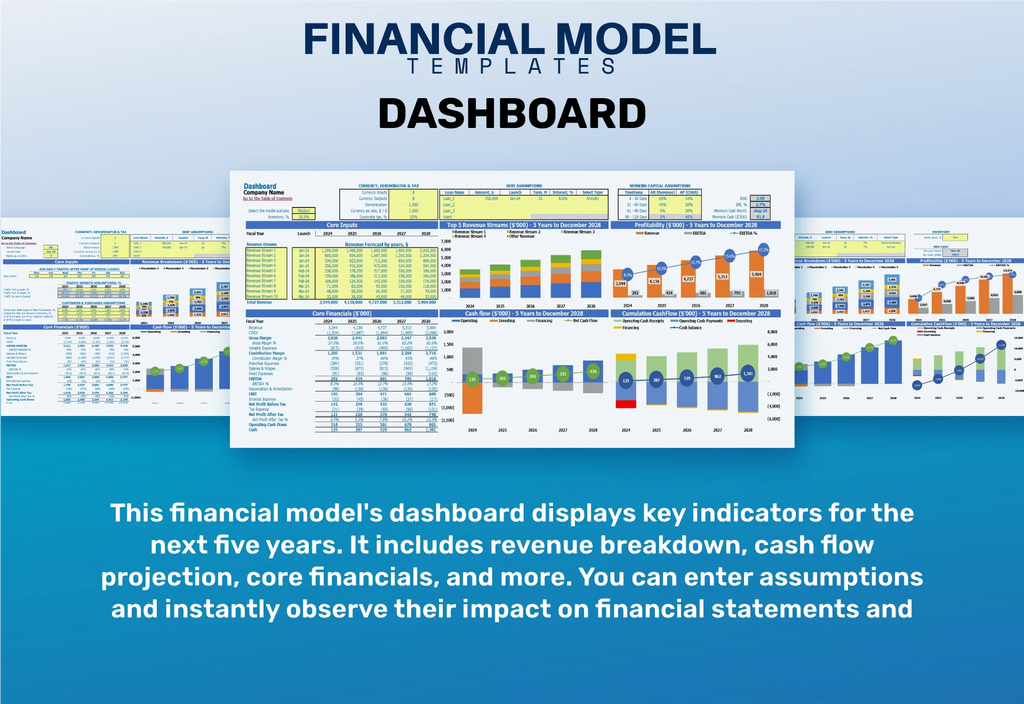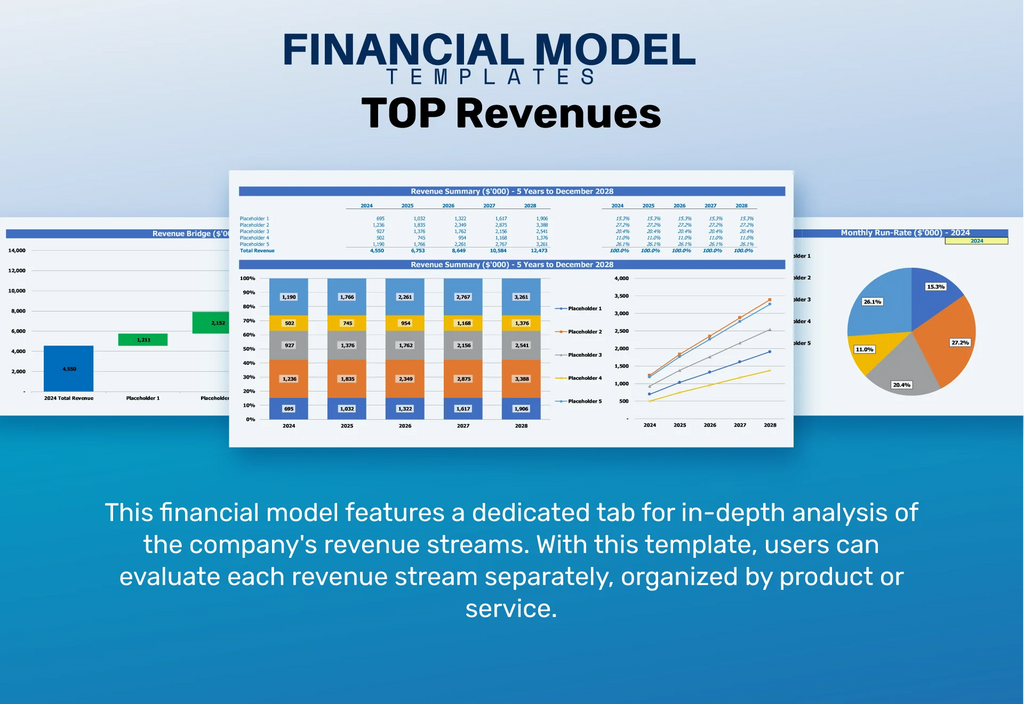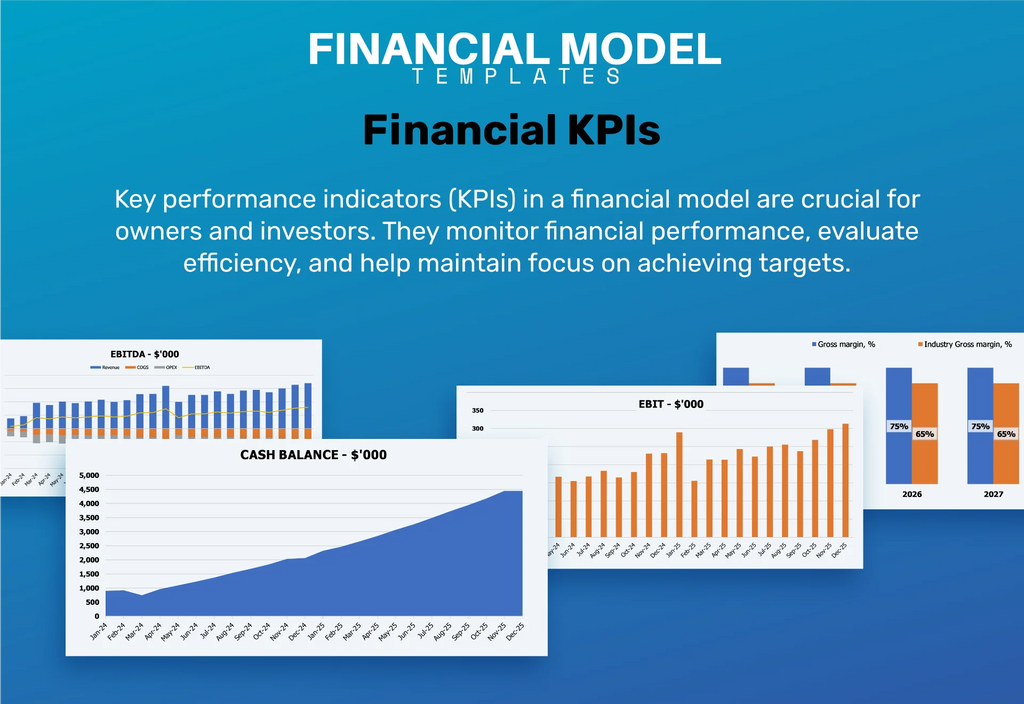Eyewear Store Financial Model

- ✔ 5-Year Financial Projections
- ✔ 100% Editable
- ✔ Investor-Approved Valuation Models
- ✔ MAC/PC Compatible, Fully Unlocked
- ✔ No Accounting Or Financial Knowledge
Eyewear Store Financial Model
Bundle Includes:
ALL IN ONE MEGA PACK - CONSIST OF:
eyewear store Financial Model/Business Plan Excel Template
Pitch Deck Template For PowerPoint, Keynote & Google Slides
Business Plan Guide and Business Plan Template in MS Word Format
Financial Dashboard in Excel To Track Your Business Performance
EYEWEAR STORE FINANCIAL MODEL FOR STARTUP INFO
Highlights
Developing a comprehensive eyewear retail business plan requires a detailed understanding of optical store profit margins and a solid sunglasses sales forecast to ensure profitability. Incorporating a robust prescription glasses pricing strategy and effective eyewear inventory management will help optimize operating expenses while maximizing eyeglass store revenue streams through strategic retail eyewear marketing strategies. Conducting thorough optical retail financial analysis, including contact lens sales projections and a break-even analysis, enables entrepreneurs to evaluate the potential of luxury eyewear sales and seasonal eyewear promotions. By leveraging e-commerce eyewear sales growth and establishing branded eyewear partnerships, businesses can enhance their customer acquisition cost while staying attuned to fashion eyewear market trends. Additionally, incorporating insights from optical industry financial benchmarking and managing lens manufacturing costs will solidify the foundation for a successful eyewear store.
This financial model offers a streamlined solution to the typical pain points faced by eyewear retail businesses, providing a comprehensive dashboard that consolidates essential reports and calculations such as optical shop break-even analysis and inventory management for prescription glasses and sunglasses. By eliminating the need to navigate multiple sheets, it allows for swift access to key metrics such as optical retail financial analysis and eyewear sales forecasts, enabling users to easily evaluate profit margins and revenue streams from contact lenses and branded eyewear partnerships. The template also incorporates insights into seasonal eyewear promotions and customer acquisition costs, empowering retailers to make informed decisions while optimizing marketing strategies and managing operating expenses effectively.
Description
The eyewear store financial modeling tool is crafted for startups and small to medium-sized enterprises in the optical retail sector, focusing on key aspects like prescription glasses pricing strategy, eyewear inventory management, and analyzing optical store profit margins. This comprehensive excel spreadsheet empowers users to conduct an optical retail financial analysis, enabling precise calculations of cash flow, break-even analysis, and identification of revenue streams from contact lens sales and sunglasses sales forecasts. Additionally, it fosters strategic planning by incorporating retail eyewear marketing strategies and seasonal promotions while facilitating projections of e-commerce eyewear sales growth and luxury eyewear sales potential. Ultimately, this financial model stands as an essential resource for understanding lens manufacturing costs, evaluating eyewear supply chain management, and optimizing customer acquisition costs in a highly competitive market.
EYEWEAR STORE FINANCIAL MODEL REPORTS
All in One Place
Develop a comprehensive and adaptable eyewear retail business plan with our powerful financial model template. Designed for versatility, it withstands changes to assumptions without compromising integrity. Our template encompasses various scenarios, ensuring a thorough optical retail financial analysis. Recognizing the uniqueness of each venture, users can effortlessly modify or tailor financial details to fit their specific needs. This robust tool is ideal for optimizing eyewear inventory management, enhancing prescription glasses pricing strategy, and forecasting sunglasses sales, all while streamlining operational expenses and maximizing profit margins in the competitive fashion eyewear market.

Dashboard
A well-crafted eyewear retail business plan is crucial for navigating the optical industry. It includes comprehensive financial statements for thorough analysis, such as pro forma cash flow projections and detailed monthly profit and loss statements. Visual aids like charts and graphs enhance clarity, enabling effective eyewear inventory management and insightful optical shop break-even analysis. This streamlined approach not only aids in monitoring operating expenses but also supports strategic decisions, from sunglasses sales forecasts to developing a robust prescription glasses pricing strategy. Ultimately, it fosters sustainable growth and maximizes revenue streams in an increasingly competitive market.

Business Financial Statements
Our financial model template for startups offers comprehensive consolidated reports, including profit and loss projections, a projected balance sheet in Excel, and a pro forma cash flow statement. These financial insights can be generated on a monthly or annual basis, enabling you to adapt to industry trends, such as eyewear retail business plans or seasonal eyewear promotions. Users can seamlessly create rolling forecasts by integrating current financial statements with Quickbooks, Xero, Freshbooks, and other accounting software, ensuring robust inventory management and informed decision-making to boost optical store profit margins and optimize revenue streams.

Sources And Uses Statement
The sources and uses statement in this financial model template outlines the key revenue streams and expenditures in the eyewear retail business plan. It provides insight into how your optical store can optimize profit margins, manage inventory effectively, and forecast sunglasses sales. Additionally, understanding operating expenses and customer acquisition costs will enhance your marketing strategies. By analyzing financial metrics, including break-even analysis and lens manufacturing costs, you can develop a robust pricing strategy for prescription glasses and capitalize on luxury eyewear sales potential. Embrace e-commerce growth and seasonal promotions to drive profits in the competitive eyewear market.

Break Even Point In Sales Dollars
The five-year break-even analysis is essential for understanding your eyewear retail business's profitability. It determines the sales volume required to cover all fixed and variable costs. Once sales exceed this point, your optical store can generate profits. Utilizing our Excel financial model template, you can create and customize a break-even chart, reflecting the minimum sales needed for profitability. Investors appreciate this analysis as it highlights potential returns. By monitoring revenue growth post-break-even, you can offer insights into how quickly investors can expect to recoup their investments, ensuring confidence in your eyewear venture.

Top Revenue
In the eyewear retail business plan, revenue forecasting is paramount, influencing key financial metrics and overall company valuation. Accurate projections rely on historical financial data and market trends, particularly in the dynamic fashion eyewear sector. Effective models prioritize growth rates and integrate components for optical store profit margins and eyeglass store revenue streams. With a focus on e-commerce eyewear sales growth and branded eyewear partnerships, businesses can enhance their financial strategies. Leverage seasonal eyewear promotions and customer acquisition cost insights for optimal performance in the competitive landscape of optical retail.

Business Top Expenses Spreadsheet
The "Top Expenses" tab within our eyewear retail business plan outlines annual expenditures categorized into four key areas. This comprehensive financial model enables an in-depth analysis of optical store operating expenses, delineating how funds are allocated—whether for customer acquisition, employee wages, or inventory management. By understanding these spending patterns, eyewear businesses can optimize their prescription glasses pricing strategy and enhance overall profitability. Moreover, insights gained from this analysis assist in tailoring retail eyewear marketing strategies, ultimately driving revenue and improving profit margins in a competitive market.

EYEWEAR STORE FINANCIAL PROJECTION EXPENSES
Costs
An eyewear store's three-statement financial model is essential for crafting cost projections and gaining insights into its financial health. This powerful five-year projection template automates data compilation, simplifying budgeting and expense tracking, crucial for understanding operating expenses. By maintaining organized budgets, eyewear retailers can identify financial gaps and present clear, professional communication to investors and lenders. This approach not only aids in strategic planning but also enhances the overall optical retail financial analysis, positioning the business for success in the competitive eyewear market.

CAPEX Spending
A capital expenditure budget is crucial for an eyewear retail business plan, serving as a key component in financial analysis and projections. Effective monitoring and evaluation of capital spending ensure optimal asset growth. Understanding development costs is essential when determining startup expenses, especially in a competitive market where inventory management and pricing strategies directly impact profit margins. As you navigate eyewear supply chain management and e-commerce opportunities, a well-structured capex plan will facilitate informed decisions and bolster overall profitability in your optical store, paving the way for sustainable revenue streams and strategic growth.

Loan Financing Calculator
Start-up and early-stage eyewear retail businesses must meticulously manage their loan repayment schedules. This detailed schedule outlines loan amounts and maturity terms, serving as a critical component of cash flow analysis. By effectively tracking principal repayments, businesses can better navigate their financing activities and forecast cash flow trends. Interest expenses, integral to the debt schedule, significantly influence the eyewear business plan and overall financial health. Staying informed about these aspects will enhance decision-making, ensuring optimal management of operating expenses and alignment with revenue streams, such as e-commerce sales growth and seasonal eyewear promotions.

EYEWEAR STORE EXCEL FINANCIAL MODEL METRICS
Financial KPIs
In the three-statement model excel, visual representations enhance the analysis of key financial metrics crucial for your eyewear retail business plan. Graphs and charts depicting earnings before interest, taxes, depreciation, and amortization (EBITDA), net income, cash flows, and cash balances streamline financial monitoring. With the capability to analyze up to five years of data—or focus on a 24-month period—these visuals will captivate investors and creditors. Effective optical retail financial analysis through clear visualizations demonstrates robust oversight of profitability, aiding in strategic decisions related to eyewear inventory management, pricing strategies, and revenue streams.

Cash Flow Forecast Excel
In a startup's financial plan, the cash flow forecast is crucial for tracking both incoming and outgoing cash flows, revealing the company's capability to fulfill its obligations. This analysis aids in assessing profit margins, particularly in the eyewear retail business. Utilizing a comprehensive P&L template is essential when engaging with banks, as financial institutions scrutinize your cash position and ability to manage debt effectively. A thorough optical retail financial analysis, key to securing funding, ensures you can capitalize on opportunities like luxury eyewear sales and e-commerce growth while maintaining optimal eyewear inventory management.

KPI Benchmarks
Leverage our financial benchmarking tool in your eyewear retail business plan to gain invaluable insights into industry performance. This intuitive feature enables you to assess your optical store's profit margins, operating expenses, and revenue streams against peers. By analyzing key metrics like prescription glasses pricing strategies and eyewear inventory management, you'll identify gaps and opportunities for improvement. Understanding your position within the fashion eyewear market trends helps you refine e-commerce strategies and enhance customer acquisition. For startups, this benchmarking process is crucial to navigating the complexities of the optical industry and driving sustainable growth.

P&L Statement Excel
For regular reporting, a monthly income and expenditure template in Excel is ideal, capturing key indicators like gross margin ratios critical for your eyewear retail business plan. An annual report provides comprehensive data, showcasing net income and post-tax profits, essential for optical retail financial analysis. Additionally, a five-year projected profit and loss statement offers valuable insights for long-term forecasting, helping to analyze eyewear inventory management and anticipate financial trends. Utilizing these tools empowers your optical shop's strategic decisions, enhancing profitability and optimizing revenue streams in the competitive eyewear market.

Pro Forma Balance Sheet Template Excel
The projected balance sheet for a startup eyewear retail business is crucial for financial planning. It outlines current and long-term assets, liabilities, and equity, serving as a foundation for evaluating optical store profit margins and operating expenses. Additionally, this report aids in calculating key financial ratios, enhancing eyewear inventory management and guiding your prescription glasses pricing strategy. By analyzing these projections, you can determine revenue streams, assess luxury eyewear sales potential, and refine customer acquisition costs. Ultimately, a robust balance sheet supports effective decision-making and strategic planning for e-commerce eyewear sales growth.

EYEWEAR STORE FINANCIAL PROJECTION TEMPLATE VALUATION
Startup Valuation Model
The pre-money valuation startup spreadsheet incorporates tools like Weighted Average Cost of Capital (WACC) and Discounted Cash Flows (DCF) analysis. WACC, a critical risk assessment metric, helps banks evaluate a company’s capital generation costs from debt and equity before loan approvals. The DCF calculation analyzes future cash flows, providing essential insights for investment opportunities. This financial analysis is vital for eyewear retail businesses, aiding in strategic decisions around optical store profit margins, prescription glasses pricing strategies, and e-commerce sales growth. Use these tools to optimize your eyewear inventory management and enhance revenue streams effectively.

Cap Table
The capitalization table (cap table) serves as a vital component of a three-statement financial model for eyewear retail start-ups. This comprehensive tool outlines the detailed distribution of company securities, highlighting investor shares, valuation, and potential dilution over time. By understanding this breakdown, entrepreneurs can make informed decisions regarding their eyewear retail business plan, optimize capital allocation, and enhance investor relations. This strategic approach is essential for navigating the competitive landscape of the optical industry and maximizing revenue streams, whether through prescription glasses pricing strategies or seasonal eyewear promotions.

KEY FEATURES
An effective financial model enhances your eyewear retail business plan, optimizing profit margins and revenue streams for sustainable growth.
Elevate your eyewear retail business plan with a strategic financial model that maximizes profit margins and ensures sustainable growth.
A robust financial model enhances eyewear retail operations by optimizing profit margins, forecasting sales, and managing inventory effectively.
Implementing a financial model ensures informed decision-making, minimizing risks and fostering sustainable growth in your eyewear retail business.
A robust financial model for your eyewear retail business plan enhances investor confidence by clearly projecting profitability and growth potential.
The eyewear retail financial analysis ensures your business plan attracts investors by clearly outlining profit margins and revenue streams.
Our financial model streamlines eyewear inventory management and maximizes profit margins, saving you time and money in your retail strategy.
An effective eyewear retail financial model streamlines planning, eliminating technical complexities while focusing on business growth and profitability.
A robust financial model enables effective eyewear inventory management and enhances optical store profit margins through informed decision-making.
Our financial model generates five-year projections and ratios, enhancing your eyewear retail business plan's accuracy and strategic decision-making.
ADVANTAGES
A flexible 5-year financial projection empowers eyewear retailers to optimize profit margins and adapt to market trends effectively.
Utilize the eyewear store financial model to effectively plan for cash gaps and enhance overall financial stability.
A robust financial projection model ensures sufficient cash flow for paying suppliers and employees, enhancing your eyewear retail success.
A robust financial model for your eyewear retail business ensures optimal expense management and maximizes profit margins for success.
Utilize our eyewear store financial model to enhance profitability, optimize inventory management, and forecast sales effectively.




